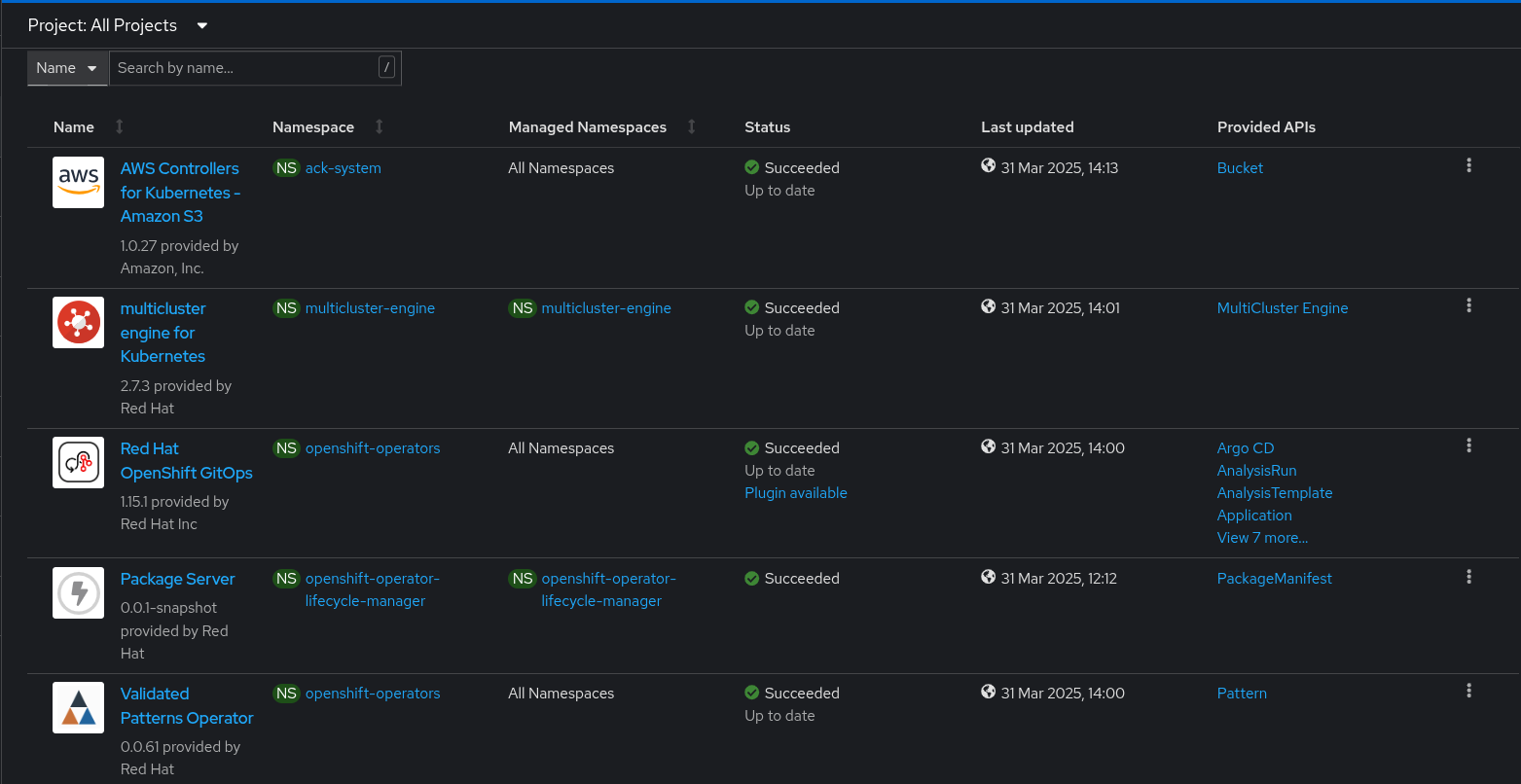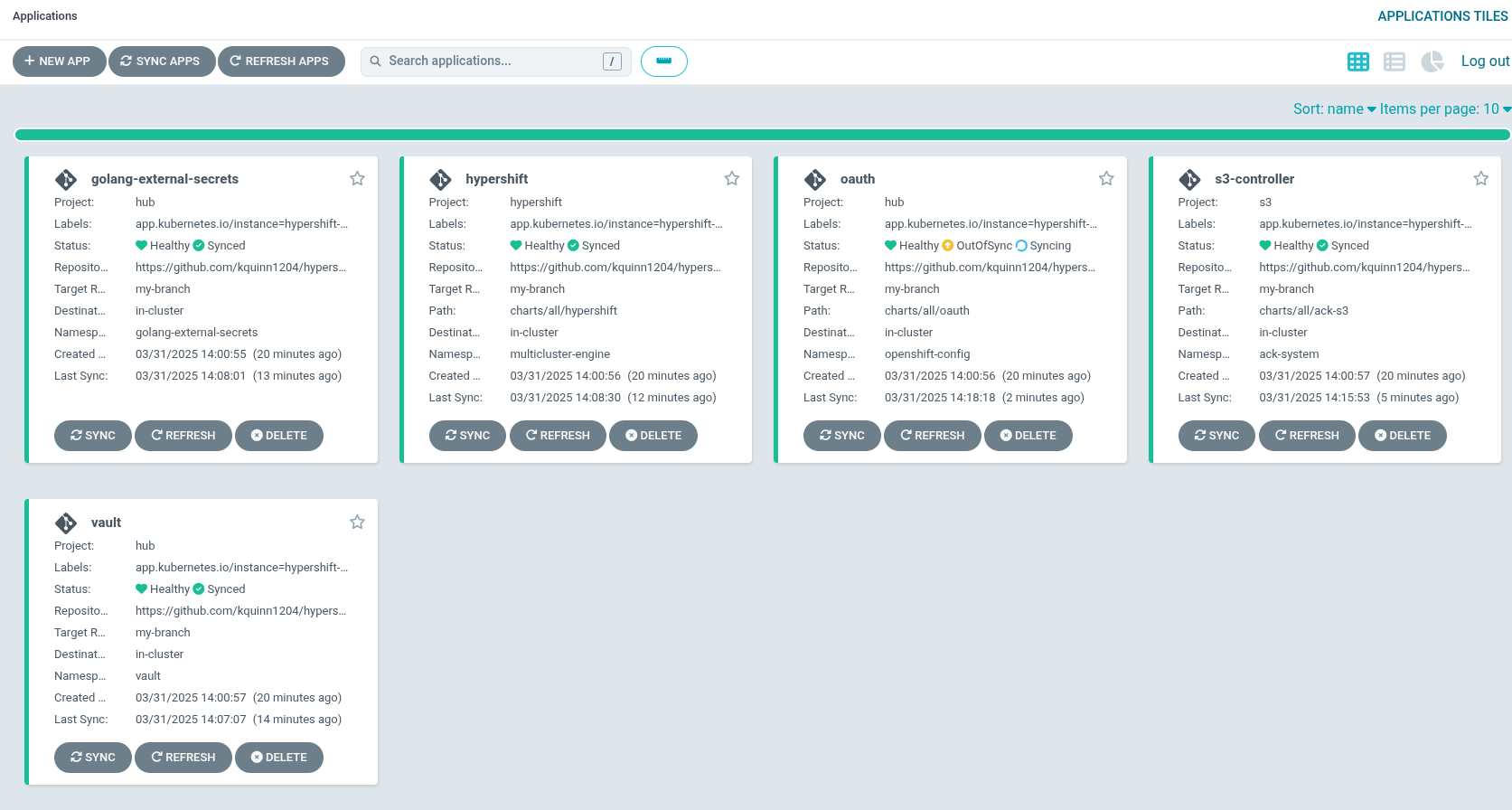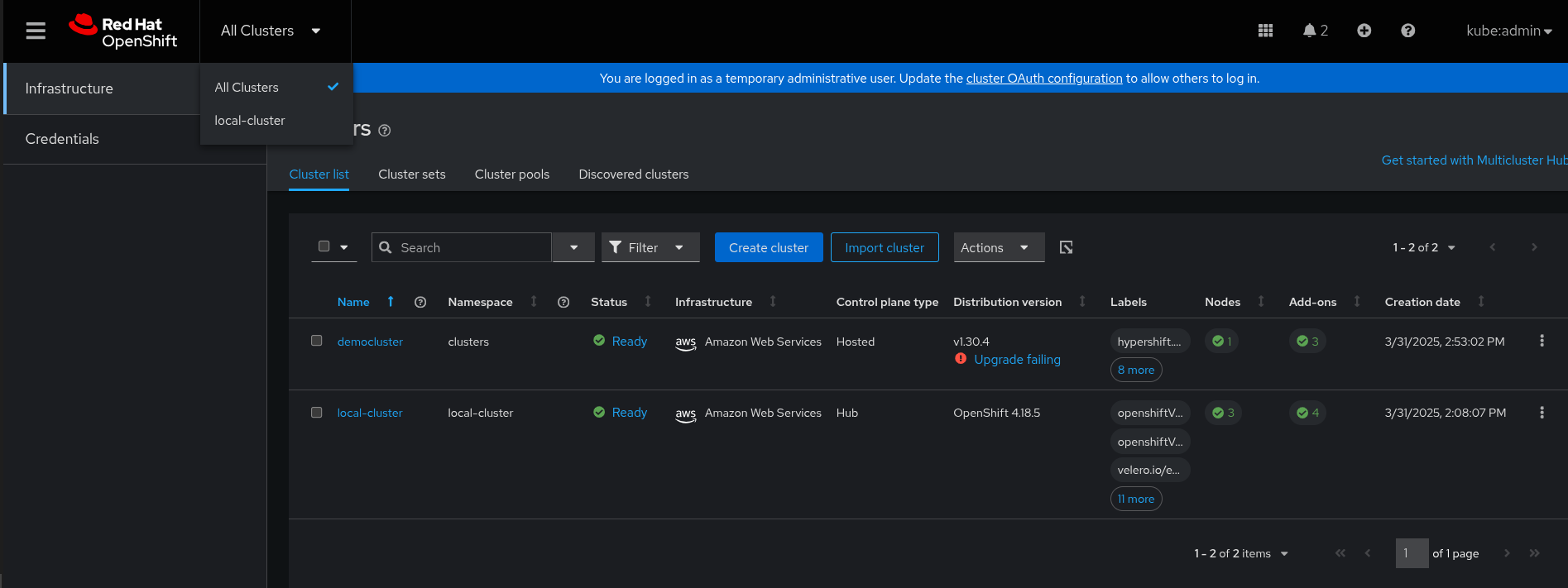$ git clone git@github.com:validatedpatterns-sandbox/hypershift.gitDeploying the hosted control plane (HyperShift) pattern
An OpenShift cluster
To create an OpenShift cluster, go to the Red Hat Hybrid Cloud console.
Select OpenShift -> Red Hat OpenShift Container Platform -> Create cluster.
A GitHub account with a personal access token that has repository read and write permissions.
The Helm binary, for instructions, see Installing Helm
Additional installation tool dependencies. For details, see Patterns quick start.
It is desirable to have a cluster for deploying the GitOps management hub assets and a separate cluster(s) for the managed cluster(s).
Preparing for deployment
Fork the hypershift repository on GitHub. You must fork the repository because your fork is updated as part of the GitOps and DevOps processes.
Clone the forked copy of this repository.
Go to your repository: Ensure you are in the root directory of your Git repository by using:
$ cd /path/to/your/repositoryRun the following command to set the upstream repository:
$ git remote add -f upstream git@github.com:validatedpatterns-sandbox/hypershift.gitVerify the setup of your remote repositories by running the following command:
$ git remote -vExample outputorigin git@github.com:kquinn1204/ansible-edge-gitops.git (fetch) origin git@github.com:kquinn1204/ansible-edge-gitops.git (push) upstream git@github.com:validatedpatterns/ansible-edge-gitops.git (fetch) upstream git@github.com:validatedpatterns/ansible-edge-gitops.git (push)Make a local copy of secrets template outside of your repository to hold credentials for the pattern.
Do not add, commit, or push this file to your repository. Doing so may expose personal credentials to GitHub.
Run the following commands:
$ cp values-secret.yaml.template ~/values-secret.yamlPopulate this file with your secrets, the defaults for AWS credentials is
~/.aws/credentials. The GitHuboauthcredentials can remain commented out:$ vi ~/values-secret.yamlCreate and switch to a new branch named
my-branch, by running the following command:$ git checkout -b my-branchEdit the
values-hypershift.yamlfile to create a S3 bucket.$ vi values-hypershift.yamlExampleglobal: s3: # Should the pattern create the s3 bucket(true), or bring your own (false). createBucket: true # What region should the bucket be created in. region: us-east-1 # Enter the name of your bucket (bucket names are globally unique) bucketName: <aws-iam-username-hcp> # Any additional tags to add to a bucket created by the pattern additionalTags: bucketOwner: <aws-iam-username> lifecycle: keepAdd the changes to the staging area by running the following command:
$ git add -uCommit the changes by running the following command:
$ git commit -m "updates to hypershift pattern"Push the changes to your forked repository:
$ git push origin my-branch
The preferred way to install this pattern is by using the script ./pattern.sh script.
Deploying the pattern by using the pattern.sh file
To deploy the pattern by using the pattern.sh file, complete the following steps:
Log in to your cluster by following this procedure:
Obtain an API token by visiting https://oauth-openshift.apps.<your-cluster>.<domain>/oauth/token/request.
Log in to the cluster by running the following command:
$ oc login --token=<retrieved-token> --server=https://api.<your-cluster>.<domain>:6443Or log in by running the following command:
$ export KUBECONFIG=~/<path_to_kubeconfig>
Deploy the pattern to your cluster. Run the following command:
$ ./pattern.sh make install
Verify that the Operators have been installed. Navigate to Operators → Installed Operators page in the OpenShift Container Platform web console,
 Figure 1. Hosted control plane Operators
Figure 1. Hosted control plane OperatorsWait some time for everything to deploy. You can track the progress through the
Hub ArgoCDUI from the nines menu. Figure 2. AHosted control plane applications
Figure 2. AHosted control plane applications
As part of installing by using the script pattern.sh pattern, HashiCorp Vault is installed. Running ./pattern.sh make install also calls the load-secrets makefile target. This load-secrets target looks for a YAML file describing the secrets to be loaded into vault and in case it cannot find one it will use the values-secret.yaml.template file in the git repository to try to generate random secrets.
For more information, see section on Vault.
At this point, a management cluster is deployed and the pattern is ready to be used to create control planes as pods on a management cluster. For more information, see Hosted control planes.
Automating the deployment of a hosted control plane nodes
A management cluster.
The
hypershiftCLI installed. For instructions, see Installing the hosted control planes command-line interface from the tereminal.The
ocCLI installed. For instructions, see Getting started with the OpenShift CLI.Ansible is installed on your system, with
kuberenetes.core collectionsPull secret obtained from Install OpenShift on AWS with installer-provisioned infrastructure and converted to json format.
AWS credentials with permissions to create IAM roles and policies.
Fork the hypershift-automation repository on GitHub.
Clone the forked copy of this repository.
$ git clone ggit@github.com:validatedpatterns/hypershift-automation.gitGo to your repository: Ensure you are in the root directory of your Git repository by using:
$ cd /path/to/your/repositoryEdit the
vars.ymlfile:vi vars.ymlExample#Actions -e create=true "creates a cluster" -e destroy=true "destroys a cluster" create: true destroy: false #Create IAM create_iam: false #Cluster Info - We use these to create/destroy clusters name: democluster domain: aws.validatedpatterns.io region: us-east-1 #Cluster Characteristics - Describe how you want the cluster deployed replicas: 1 instance_type: m5.xlarge #Setting to default uses the hosting-clusters version for the release-image. To deploy with a specific #version, define it below: x.y.z (4.15.29) image: 4.17.0Run the following command to create the hosted control plane:
$ make buildThis will take some time to create the hosted control plane and nodepool configuration.
In the OpenShift container platform web console select All Clusters to display the Cluster list. A screen similar to the following is displayed:
 Figure 3. Hosted control plane cluster list
Figure 3. Hosted control plane cluster listSelect for example the democluster to display the Cluster details page. A screen similar to the following is displayed:
 Figure 4. Hosted control plane cluster details
Figure 4. Hosted control plane cluster detailsClick Download kubeconfig to download the
kubeconfigfile for the hosted control plane.
Export the management cluster kubeconfig:
$ export MGMT_KUBECONFIG=</path/to/management-cluster-kubeconfig>Run this command to find the
node-pool-namefor your cluster:$ oc --kubeconfig="$MGMT_KUBECONFIG" get np -AExample outputNAMESPACE NAME CLUSTER DESIRED NODES CURRENT NODES AUTOSCALING AUTOREPAIR VERSION UPDATINGVERSION UPDATINGCONFIG MESSAGE clusters democluster-us-east-1a democluster 1 1 False False 4.17.0 False FalseRun this command to export the downloaded
kubeconfigfile for your hosted control plane:$ export HCP_KUBECONFIG=</path/to/hypershift-cluster-kubeconfig>Use the
kubeconfigfile to view the cluster Operators of the hosted cluster. Enter the following command:$ oc --kubeconfig="$HCP_KUBECONFIG" get coExample outputNAME VERSION AVAILABLE PROGRESSING DEGRADED SINCE MESSAGE console 4.17.0 True False False 57m csi-snapshot-controller 4.17.0 True False False 66m dns 4.17.0 True False False 57m image-registry 4.17.0 True False False 57m ingress 4.17.0 True False False 57m insights 4.17.0 True False False 58m kube-apiserver 4.17.0 True False False 66m kube-controller-manager 4.17.0 True False False 66m kube-scheduler 4.17.0 True False False 66m kube-storage-version-migrator 4.17.0 True False False 58m monitoring 4.17.0 True False False 55m network 4.17.0 True False False 65m node-tuning 4.17.0 True False False 60m openshift-apiserver 4.17.0 True False False 66m openshift-controller-manager 4.17.0 True False False 66m openshift-samples 4.17.0 True False False 57m operator-lifecycle-manager 4.17.0 True False False 66m operator-lifecycle-manager-catalog 4.17.0 True False False 65m operator-lifecycle-manager-packageserver 4.17.0 True False False 66m service-ca 4.17.0 True False False 58m storage 4.17.0 True False False 60mView the running pods on your hosted cluster by entering the following command:
$ oc --kubeconfig="$HCP_KUBECONFIG" get pods -AExample outputNAMESPACE NAME READY STATUS RESTARTS AGE kube-system konnectivity-agent-56gh5 1/1 Running 0 66m kube-system kube-apiserver-proxy-ip-10-0-129-28.ec2.internal 1/1 Running 0 66m open-cluster-management-agent-addon cluster-proxy-proxy-agent-7c7666c8f8-9d2xb 3/3 Running 0 64m open-cluster-management-agent-addon klusterlet-addon-workmgr-56c67649b6-8flx7 1/1 Running 0 64m open-cluster-management-agent-addon managed-serviceaccount-addon-agent-56d8f7c4bd-krtwt 1/1 Running 0 64m openshift-cluster-csi-drivers aws-ebs-csi-driver-node-tvgt9 3/3 Running 0 66m openshift-cluster-node-tuning-operator tuned-kmlsm 1/1 Running 0 66m openshift-cluster-samples-operator cluster-samples-operator-6895b9d4c7-nsm54 2/2 Running 0 64m openshift-console-operator console-operator-67d5f87dcc-hdv5j 1/1 Running 2 (64m ago) 64m openshift-console console-fcb9d74fc-5jkfx 1/1 Running 0 61m openshift-console downloads-57848c99-8t8xn 1/1 Running 0 64m openshift-dns dns-default-n62b6 2/2 Running 0 65m openshift-dns node-resolver-25vsw 1/1 Running 0 66m openshift-image-registry image-registry-5778996bc4-v4dw6 1/1 Running 1 (63m ago) 64m openshift-image-registry node-ca-qf4fv 1/1 Running 0 66m openshift-ingress-canary ingress-canary-rlz5k 1/1 Running 0 65m openshift-ingress router-default-7fc88ff765-88zt6 1/1 Running 0 64m openshift-insights insights-operator-567c5dd9fc-vhkr5 1/1 Running 1 (63m ago) 64m openshift-kube-storage-version-migrator-operator kube-storage-version-migrator-operator-5d64f77d9f-tbrmm 1/1 Running 1 (63m ago) 64m openshift-kube-storage-version-migrator migrator-76b9bc6b54-mjwwn 1/1 Running 0 64m openshift-machine-config-operator kube-rbac-proxy-crio-ip-10-0-129-28.ec2.internal 1/1 Running 0 66m openshift-monitoring alertmanager-main-0 6/6 Running 0 62m openshift-monitoring cluster-monitoring-operator-6589b986c8-bjb2t 1/1 Running 0 64m openshift-monitoring kube-state-metrics-575c55f885-xcwvp 3/3 Running 0 63m openshift-monitoring metrics-server-766fb8749c-qmbkp 1/1 Running 0 63m openshift-monitoring monitoring-plugin-5567ddf44-vgrwx 1/1 Running 0 63m openshift-monitoring node-exporter-gh76w 2/2 Running 0 63m openshift-monitoring openshift-state-metrics-7466fd7977-hqmwv 3/3 Running 0 63m openshift-monitoring prometheus-k8s-0 6/6 Running 0 62m openshift-monitoring prometheus-operator-5cf88995b6-sqqfq 2/2 Running 0 64m openshift-monitoring prometheus-operator-admission-webhook-7d744487ff-8xb7b 1/1 Running 0 64m openshift-monitoring telemeter-client-857df5b745-9v579 3/3 Running 0 62m openshift-monitoring thanos-querier-585746b745-thnfc 6/6 Running 0 63m openshift-multus multus-additional-cni-plugins-njkgb 1/1 Running 0 66m openshift-multus multus-k6ggs 1/1 Running 0 66m openshift-multus network-metrics-daemon-45wq7 2/2 Running 0 66m openshift-network-console networking-console-plugin-78b59bd487-ms4c7 1/1 Running 0 64m openshift-network-diagnostics network-check-source-7fbf9dfccb-ddvld 1/1 Running 0 64m openshift-network-diagnostics network-check-target-vvktk 1/1 Running 0 66m openshift-network-operator iptables-alerter-5s96x 1/1 Running 0 65m openshift-ovn-kubernetes ovnkube-node-9rsw4 8/8 Running 0 66m openshift-service-ca-operator service-ca-operator-7b9f58bd4b-b62m6 1/1 Running 1 (63m ago) 64m openshift-service-ca service-ca-554d4b766c-82h22 1/1 Running 0 64m
